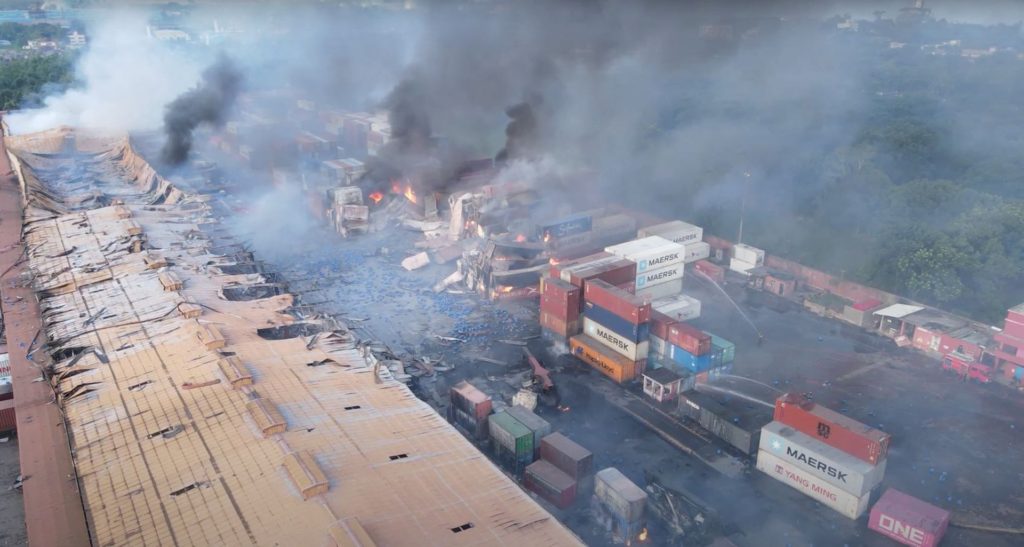On June 4, Saturday, at 9 pm, a fire broke out in Sitakunda’s container facility, located 25 miles from the Chittagong port. While firefighters were attempting to salvage the situation, the fire triggered multiple explosions around midnight. The explosions resulted in around 49 deaths and over 300 injuries.
Chittagong’s Chief Doctor, Elias Chowdhury, has proclaimed that the number of deceased may rise as many of the injured are in a critical state. The loss of lives and resources has caused turmoil in the state. People are making speculations about how the situation spiraled out of control.
The fire started in a container full of hydrogen peroxide chemicals and spread rapidly to other containers. Some of the other containers were holding garment products.
Hydrogen peroxide is an effective oxidizing agent and becomes explosive when heated due to thermal decomposition. When firefighters arrived at the scene, they did not have a clue about the chemical. To them, it was a small fire they were prepared to douse. However, a massive explosion shook the site when the firefighters were busy extinguishing the blaze. The blast engulfed many of the rescuers in its flames and threw debris into the air. After the explosion, the fire spread quickly, and the situation escalated. Army officials had to join the 32 fire service units on Sunday noon to salvage the situation. 6 firefighters died in the explosion.
The disaster on Saturday left a horrific sight to behold in its take. The explosion threw a lorry driver, Tofael Ahmed, 10 meters from where he stood. His hands and legs are burnt, and this is just one person. Medical facilities are overwhelmed as many people are waiting for treatments in the hallways. There have been requests for blood donations from the medics.
The explosion had occurred in the middle of the dock and was so massive that it shattered the windows of nearby buildings. Some people reported that they had heard the blast from 30-40 km away.
Locals used the expression “fireballs falling like rain” as the explosion sent debris flying in the air. There were scraps of metal shipping contained around the area. Besides, containers are reeking chemical fumes causing a pungent odor at the site. There are a lot of chemicals on the ground as well. Locals reported having trouble breathing. In addition, firefighters are concerned about the presence of chemical compounds in the remaining containers. It may cause more explosions and could be a threat to the locals and the neighborhood.

The container depot at Sitakunda has been in operation since May 2011. Situkanda acts as a transit point for goods traveling through the port and stores around 4000 containers. During the blast, it had millions of dollars worth of garments ready for export.
According to the Bangladesh Inland Container Depots Association (BICDA), the fire caused a primary loss of $110 million.
The loss includes loaded containers worth over $90 million and empty containers worth around $20 million. Although the apparel manufacturers may get some compensation as the products had insurance coverage, this incident will remain a bitter experiment for them. International trade may face a roadblock due to the Sitakunda fiasco.
The Dhaka Tribune published a list on Sunday that contained the description of 12 industrial disasters since 2005. After the Rana Plaza incident, industrial facilities have reformed their security measures and protocols. However, industrial fires remain a common phenomenon in Bangladesh.
Most people blame it on inept safety regulations, but that is not the case for the container depot blast. The root causes were inadequate storage facilities, lack of information, and sheer mockery of legalities.
Chemicals like hydrogen peroxide need dedicated infrastructures for storage. The depot was not the appropriate place to store the chemical. The Inspector of the Chattogram Explosives Department proclaimed that they did not have a clue about chemicals at the depot. It is against the law to hoard threatening chemical compounds in an area surrounded by a locality. The firefighters did not receive any information about the chemical, and none of the depot people helped them locate it. The lack of proper information relay delayed the operation.
Government and army officials are attempting to mitigate the situation. The army has deployed sandbags to prevent chemicals from passing into the Indian Ocean and other water channels. Home Minister Asaduzzaman Khan intends to initiate an investigation to find the perpetrators behind the incident. Three separate committees are investigating the matter. State Minister for Labor and Employment has issued compensations for the families of the deceased. However, none of these initiatives warrant that there will not be another Sitakunda fiasco. This explosion claimed more firefighter lives than any other incident so far. For some, it is like the Beirut blast all over again.
The incident begs the question, “Why has the safety of people become a secondary concern for authorities?”